The brake system components found on competition vehicles have complex and demanding requirements placed on them. Combining high speeds, repetitive braking, and little time for cooling in-between, racetracks have the capability of exposing weaknesses in even the very best stock braking systems in only a few laps. Naturally, the consequences of brake system failure under these conditions is to be avoided at all costs, so when preparing a vehicle for competition, the brake system is usually given priority over more discretionary items.
At the same time, purchasing and installing a big brake kit may not be a viable solution for improving your brake system performance. Constraints such as sanctioning body rules, regulations, or simple budgetary limitations often dictate that the only way to address brake system performance on track is to stick with the factory hardware and improvise. In other words, not everyone has the luxury of bolting on a set of 14-inch floating rotors and 6-piston calipers to address their brake system performance concerns.

No matter what you race, always check your sanctioning body’s rulebook before buying any new brake parts, as certain modifications may be prohibited. Consequently, it may require more creativity than cash to make significant brake system performance improvements. In cases like this, a solid understanding of brake system fundamentals ensures that your elbow grease is applied in the correct areas. (Randall Shafer)
To provide you with ideas to help you choose your own upgrades, this chapter illustrates some of the most common brake system modifications when racing a production-based vehicle. Note that any time you embark on a project such as this, you should not be second-guessing your design, fabrication, or installation abilities. If in doubt, enlist the services of a professional to ensure that the integrity of the modified components is not compromised in any way!
The Vehicle
In contrast to the daily-driver BMW modified in Chapter 11, the focus of attention in Chapter 12 is a 1972 Porsche 911 prepared exclusively for road racing. Competing primarily in the PCA GT-4s category, this vehicle is occasionally run in SCCA Club Racing events in the GT2 category as well as SVRA group 10c competition. It is truly a jack of all trades, and, as a result, must comply with sanctioning body requirements in multiple classes simultaneously.
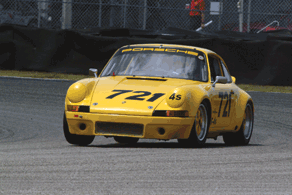
Racing in vintage classes may require participants to adhere to arcane rules and regulations from the past. While this is certainly part of the allure of vintage competition, it may prevent you from using modern brake system technology. The 1972 Porsche 911 modified in the pages that follow falls exactly into this category. (Daniel Mainzer)
The Objective
With approximately 280 hp at the crankshaft and weighing in at just 2,000 pounds, this vehicle is capable of generating a significant amount of kinetic energy in a very short amount of time. Consequently, the stock brake system, designed for much less power and significantly more weight, was not able to keep up with the rest of the vehicle’s performance capability.
While brake fade was being managed through friction material selection and a brake fluid upgrade, brake pad taper, brake pad life, and rotor cracking were all causing headaches on track. In addition, there was no adjustability in the stock brake system to adjust the brake balance for the vehicle in full race trim, resulting in extended stopping distances.
Therefore, the objective of this upgrade was to increase the thermal capacity of the brake system in order to reduce brake temperatures to more manageable levels without causing unwanted changes in brake system gain or brake balance. At the same time, a caliper upgrade was deemed necessary to reduce taper wear and consequently improve brake pedal feel. However, between a typical club racer’s budget and a vintage racing requirement to maintain a 15-inch wheel diameter, a typical big brake upgrade was not on the agenda.
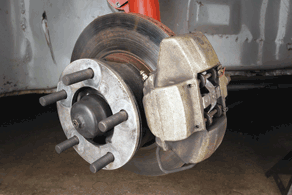
Although it was world-class at the time, the stock 911 brake system from 1972 is only considered average by modern standards. Between the additional horsepower and modern race tires installed for competition, it didn’t take many laps to realize the need for increased thermal capacity. The vintage brake systems found on Camaros, Corvettes, and Mustangs from the same era typically don’t fare too well, either. (Randall Shafer)
Front Brake Upgrade
The first step in the upgrade was to do some research to find out if any other models were offered by the same manufacturer that came with more robust brake-system hardware. Fortunately, Porsche offered an upgraded brake system on the 911 Turbo models, which fits under 15-inch wheels while still being reasonably affordable (in relative terms) when purchased used.
As a result, this was the chosen upgrade path: bolt on the Turbo parts. The only problem was that they didn’t just bolt on.
Rotor Selection and Modification
To address brake system temperatures, the first order of business was to select new front rotors. The stock 911 front rotors measured 11.1 inches in diameter and 0.8 inches in thickness—not too bad for 1972, but relatively small by contemporary standards. The Turbo rotors were a more significant 12.0 inches in diameter and 1.3 inches in thickness, but the hat geometry would not allow for a bolt-on installation. Consequently, aftermarket two-piece friction discs (using Turbo rotor dimensions) with custom hats were the first modification.
While custom hats are readily available in the aftermarket, the owner fabricated a pair in the shop from a piece of 6061 aluminum. The only downside to the home-built hats was that it was not possible to implement a floating interface between the friction disc and the hat. Instead, the two were bolted rigidly together using aircraft-grade hardware. Although the weight savings of a two-piece rotor would be realized, the larger rotor would be no more robust to coning than the stock 911 rotor.
In a cost-savings move the front rotors were not slotted, nor were they cross-drilled for fear of reduced durability. However, the curved-vane design of the larger rotors was expected to move more cool air through the friction disc than the straight-vaned stock rotors, so the benefit was more than size alone.
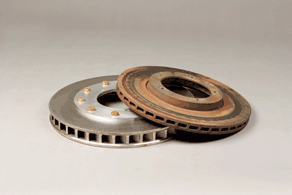
The custom, two-piece front rotor shown on the left is 0.9 inches larger in diameter than the stock 911 rotor shown on the right, but even more impressive was the 0.5-inch growth in thickness. While thermal mass increased significantly (approximately five pounds per rotor), fabricating the hats from aluminum offset some of the rotational inertia impacts of the new rotors. (Randall Shafer)
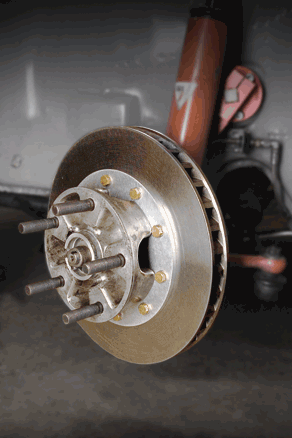
After a significant amount of trial and error, the owner bolted the custom front rotors and hats onto the front suspension. The friction discs selected are neither slotted nor cross-drilled to reduce cost, but their curved vane geometry is clearly visible. (Randall Shafer)
Caliper Selection and Modification
To accompany the front rotor upgrade, the owner purchased a pair of Turbo calipers at a local swap meet. Compared to the stock 911 two-piston calipers, the Turbo four-piston calipers certainly looked much more like racecar parts. The fact that they fit under the stock 911 15-inch wheels using only a pair of custom bracket spacers sealed the deal.
Functionally, the Turbo calipers used a larger brake pad than the stock 911 calipers, providing increased friction material volume for better brake pad life and lower brake pad temperatures. The four-piece construction of the Turbo calipers also provided increased stiffness compared to the stock 911 monoblock calipers, but with the penalty of a slight weight increase.
Although the Turbo calipers used four pistons, they did not contain differential bores. Instead, all four bores measured 1.5 inches in diameter. However, compared to the stock two-piston 911 caliper, the pressure distribution across the brake pad backing plate was improved and consequently was expected to decrease the occurrence of longitudinal brake pad taper by some amount.
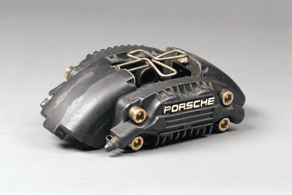
The front Turbo calipers were a four-piece design (one inboard piston housing, one outboard piston housing, and two bridge pieces) in contrast to the stock 911 aluminum monoblock calipers. The cross-shaped piece of wire on the top of the caliper acts as the brake pad retaining device. (Randall Shafer)
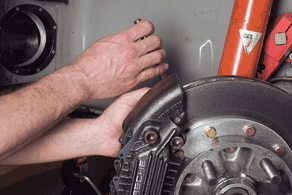
The front Turbo calipers bolted on to the stock 911 front suspension with little modification at all. The 3.5-inch center-to-center caliper fastener placement was common to both caliper bodies, requiring only a few small spacers to align the caliper body with the rotor friction disc. Owners of many American vehicles of this vintage will have similar luck finding parts that practically bolt on without significant modification. (Randall Shafer)
The front Turbo calipers bolted on to the stock 911 front suspension with little modification at all. The 3.5-inch center-to-center caliper fastener placement was common to both caliper bodies, requiring only a few small spacers to align the caliper body with the rotor friction disc. Owners of many American vehicles of this vintage will have similar luck finding parts that practically bolt on without significant modification. (Randall Shafer)